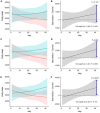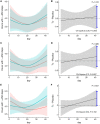Effect of a pragmatic home-based mobile health exercise intervention after transcatheter aortic valve replacement: a randomized pilot trial
- PMID: 34048509
- PMCID: PMC8139414
- DOI: 10.1093/ehjdh/ztab007
Effect of a pragmatic home-based mobile health exercise intervention after transcatheter aortic valve replacement: a randomized pilot trial
Erratum in
-
Erratum.Eur Heart J Digit Health. 2021 Nov 21;3(1):115-116. doi: 10.1093/ehjdh/ztab098. eCollection 2022 Mar. Eur Heart J Digit Health. 2021. PMID: 36713986 Free PMC article.
Abstract
Aims: Impaired physical function is common in patients undergoing transcatheter aortic valve replacement (TAVR) and associated with worse outcomes. Participation in centre-based cardiac rehabilitation (CR) after cardiovascular procedures is sub-optimal. We aimed to test a home-based mobile health exercise intervention as an alternative or complementary approach.
Methods and results: At five centres, after a run-in period, eligible individuals treated with TAVR were randomized 1:1 at their 1-month post-TAVR visit to an intervention group [activity monitor (AM) with personalized daily step goal and resistance exercises] or a control group for 6 weeks. Among 50 participants, average age was 76 years, 34% were female, average STS score was 2.91.8, and 40% had Short Physical Performance Battery (SPPB) 9. Daily compliance with wearing the AM and performing exercises averaged 8590%. In the intention to treat population, there was no evidence that the intervention improved the co-primary endpoints: daily steps +769 (95% CI 244 to +1783); SPPB +0.68 (0.27 to 1.53); and Kansas City Cardiomyopathy Questionnaire 1.7 (9.1 to 7.1). The intervention did improve secondary physical activity parameters, including moderate-to-intense daily active minutes (P<0.05). In a pre-specified analysis including participants who did not participate in CR (n=30), the intervention improved several measures of physical activity: +1730 (1003360) daily steps; +66 (28105) daily active minutes; +53 (2780) moderate-to-intense active minutes; and 157 (265 to 50) sedentary minutes.
Conclusion: Among selected participants treated with TAVR, this study did not provide evidence that a pragmatic home-based mobile health exercise intervention improved daily steps, physical performance or QoL for the overall cohort. However, the intervention did improve several measures of daily activity, particularly among individuals not participating in CR.
Trial registry: Clinicaltrials.gov NCT03270124.
Keywords: Accelerometer; Actigraphy; Aortic stenosis; Cardiac rehabilitation; Frailty; Mobile health; Transcatheter aortic valve replacement.
The Author(s) 2021. Published by Oxford University Press on behalf of the European Society of Cardiology.
Figures







Comment in
-
Home-based mobile health exercise intervention: a solution to increase physical activity in recipients of transcatheter aortic valve replacement?Eur Heart J Digit Health. 2021 Feb 9;2(1):88-89. doi: 10.1093/ehjdh/ztab014. eCollection 2021 Mar. Eur Heart J Digit Health. 2021. PMID: 36711171 Free PMC article. No abstract available.
References
-
- Afilalo J, Lauck S, Kim DH, Lefevre T, Piazza N, Lachapelle K, Martucci G, Lamy A, Labinaz M, Peterson MD, Arora RC, Noiseux N, Rassi A, Palacios IF, Genereux P, Lindman BR, Asgar AW, Kim CA, Trnkus A, Morais JA, Langlois Y, Rudski LG, Morin JF, Popma JJ, Webb JG, Perrault LP.. Frailty in older adults undergoing aortic valve replacement: the FRAILTY-AVR Study. J Am Coll Cardiol 2017;70:689–700. - PubMed
-
- Abdul-Jawad Altisent O, Puri R, Regueiro A, Chamandi C, Rodriguez-Gabella T, Del Trigo M, Campelo-Parada F, Couture T, Marsal JR, Cote M, Paradis JM, DeLarochelliere R, Doyle D, Mohammadi S, Dumont E, Rodes-Cabau J.. Predictors and association with clinical outcomes of the changes in exercise capacity after transcatheter aortic valve replacement. Circulation 2017;136:632–643. - PubMed
-
- Goel K, O'Leary JM, Barker CM, Levack M, Rajagopal V, Makkar RR, Bajwa T, Kleiman N, Linke A, Kereiakes DJ, Waksman R, Allocco DJ, Rizik DG, Reardon MJ, Lindman BR.. Clinical implications of physical function and resilience in patients undergoing transcatheter aortic valve replacement. J Am Heart Assoc 2020;9:e017075. - PMC - PubMed
-
- Lindman BR, Arnold SV, Bagur R, Clarke L, Coylewright M, Evans F, Hung J, Lauck SB, Peschin S, Sachdev V, Tate LM, Wasfy JH, Otto CM.. Priorities for patient-centered research in valvular heart disease: a report from the National Heart, Lung, and Blood Institute Working Group. J Am Heart Assoc 2020;9:e015975. - PMC - PubMed
Associated data
Grants and funding
LinkOut - more resources
Full Text Sources
Other Literature Sources
Medical
